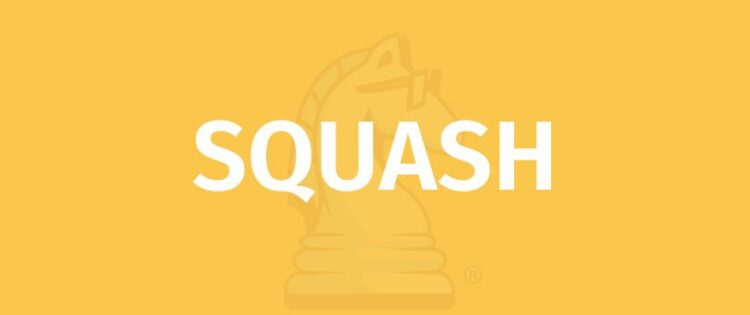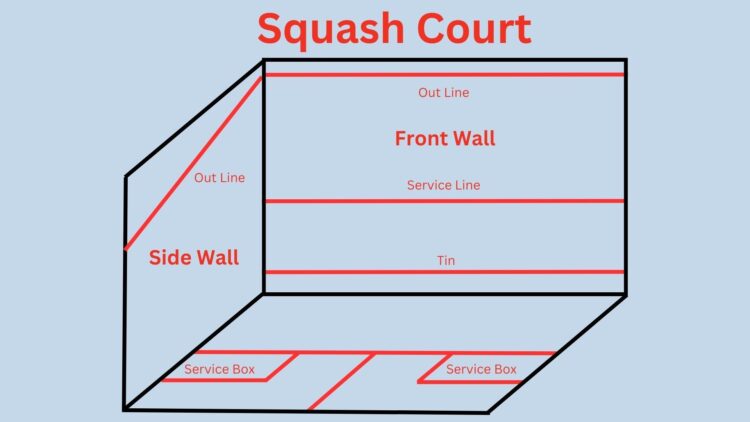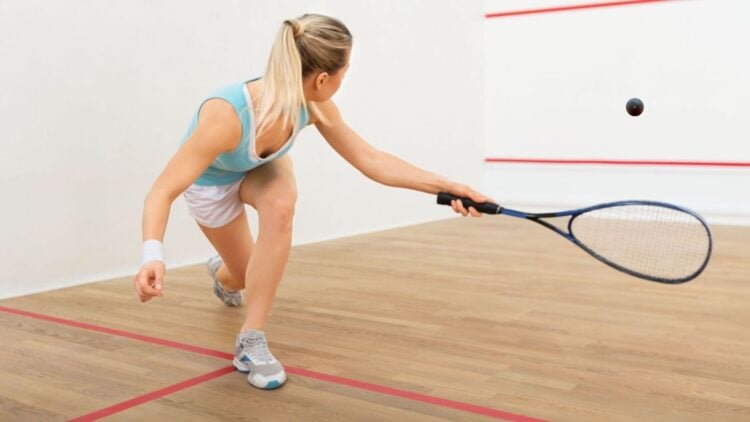
OBJECTIVE OF SQUASH: Be the first to score a predetermined amount of points by hitting the ball against a wall in a manner that leaves the opponent unable to legally return it.
NUMBER OF PLAYERS: 2 players
MATERIALS: Racket, ball
TYPE OF GAME: Sport
AUDIENCE: 5+
OVERVIEW OF SQUASH
Squash is a racket-and-ball sport similar to racquetball and paddleball. Competitors play in a four-walled courts. The teams take turns hitting the ball, aiming to hit the ball against the front wall in a way so that their opponent cannot legally return it before the ball bounces twice on the ground.
The rules of Squash grew out of the game of rackets, which was played in prisons by inmates in 19th-century London. In the mid-1800s, school kids began noticing that balls that “squashed” on impact with the wall were much more fun to play with. Over time, kids continued to change the ball, rackets, and rules of the game.
Squash quickly began spreading to other countries, with the first squash court in the United States being constructed in Concord, New Hampshire, in 1884. By 1904, the first national association of the sport, now known as “US Squash”, was formed in Philadelphia. Squash was so popular, in fact, that there was even a court on the RMS Titanic!
Since then, squash has steadily spread to include more than 50,000 courts found in 188 countries worldwide. Squash is most popular in England, although Germany, Egypt, and the United States follow closely behind. There have been efforts to include the sport in the Olympic program, although all such attempts have so far been unsuccessful.
SETUP
EQUIPMENT
- Racket: Can be up to 27 inches long, 8.5 inches wide, and have a racket head size of no more than 77 square inches. To put it in perspective, a full-size tennis racket is between 27–29 inches long, 12.5 inches wide, and has a racket head size close to 100 square inches.
- Squash Ball: 1.6-inch (in diameter) hollow rubber balls. Different squash balls have varying bounce heights and are used for different levels of competition.
SQUASH BALLS
There are six types of squash balls, each recognizable by the colored dot on the black colored ball. Here are the different colors.
- Orange
- Double Yellow (2 yellow dots)
- Yellow
- Green
- Red
- Blue
Blue balls are the most bouncy, while orange balls are the least bouncy. Due to the nature of the sport, balls that bounce less are actually used for more experienced players, with the competition standard being double yellow.
Orange balls are generally only used for competitions that take place in high-altitude locations.
THE SQUASH COURT

Squash courts are 32 feet long, 21 feet wide, and 18.5 feet tall (shorter length, greater width compared to racquetball courts). They consist of a front wall, a side wall of each side of the court and a back wall.
- Two service boxes are located on both sides of the court, which is where the players must serve.
- A half-court line separates the squash court length-wise; the served ball must reach the opposite side of the half-court line from which it was served.
- A mid-court line separates the court width-wise and intersects the half-court line, with this line indicating from where a player must serve.
On the front wall, there are three horizontal lines.
- About 1.4 feet off the ground is the “tin”, which is a section of the wall that sticks out. Any ball that hits the tin is considered out.
- Nearly six feet above the tin is the “service line”. All serves must be hit above the service line in order to be legal.
- 15 feet from the floor is the “out line”. All balls need to be played below this point in order to be legal. If a ball hits either the out line or the tin line they are out.
GAMEPLAY

SERVING
The game starts with a serve. To determine which player serves in the first game, flip a coin, play rock-paper-scissors, or spin a racquet. After the initial game, the player who wins the previous game serves first in the next game.
The server can choose either of the service boxes to serve from, and the opposing player must situate themself on the other side of the court but behind the mid-court line.
When serving, the player must have at least one foot entirely inside the service box at all times until the ball is hit. Otherwise, a “foot fault” is called. When the ball is hit, the ball must hit the frontal wall between the service and out lines and then land on the opposite side of the court between the half-court line and the back wall.
Each player only gets one chance to serve, and if the player fails to serve legally, it ends in a point to the opposing player. However, the service only changes hands when the server loses a point, when the receiving player legally returns the ball before it bounces twice.
If the server wins the ensuing rally, they continue to serve but alternate between the two service boxes.
SCORING
A point is scored in squash when a player hits a shot that the opponent fails to return before the ball bounces twice. All squash games are decided by the first player to reach 9, 11, or 13 points, depending on the tournament. Most squash games are generally played to 11 points.
In other words, the first player to reach 9, 11, or 13 points wins the game. However, if a game goes up to 11 points and the score is 10-10, the game continues until a player wins by 2 points.
Most squash matches are played in a best-of-five format, with the first player to win three games winning the entire match.
RULES
Here is a list of rules that indicate what players can and cannot do during a match:
- Players can hit the ball against any side or back walls as long as eventually the ball hits the front wall before bouncing on the ground twice.
- Players are allowed to “volley” the ball by hitting it before it touches the ground.
- The player who hits the ball must get out of the way of the ball’s path so as to not interfere with their opponent.
- The ball must be hit cleanly; it is against the rules to “carry” the ball. Meaning the ball makes contact with the racquet for longer than normal.
- A serve must make it to the back corner of the opposite side of the court after hitting the front wall.
Any violation of rules results in a point for the opponent.
LET AND STROKE
A let is called if there is interference during play, such as one player obstructing the other’s shot or hindering their movement. A let results in replaying the point without any player being awarded the point.
A stroke is called if a player’s swing is intentionally or unintentionally prevented by the opponent. When a stroke is called, the obstructed player is granted a point.
PAR SCORING
An alternative method to play squash is by using the “par” scoring system. This method of scoring makes it so a player is only able to score points off of their own serves. This means that a player’s objective when their opponent serves is to stop them from scoring a point, as opposed to the basic rules of scoring a point themself.
END OF GAME
A squash match ends after a competitor wins three of the five games.
- 30 GAMES TO PLAY OVER TEXT - April 22, 2024
- 20+ FREE PRINTABLE BABY SHOWER GAMES - April 16, 2024
- 20+ College Party Games for the Best Night Ever! - April 2, 2024